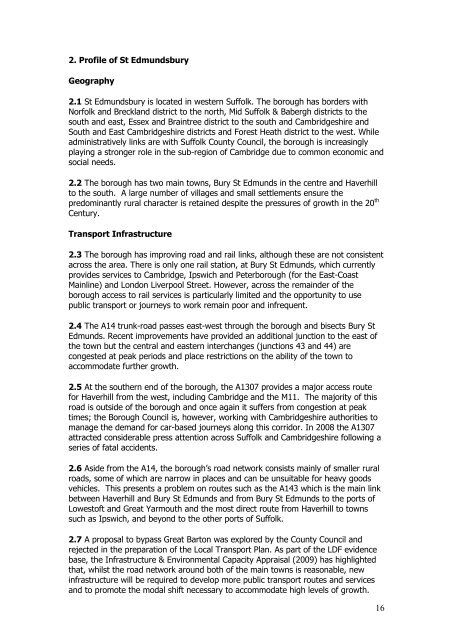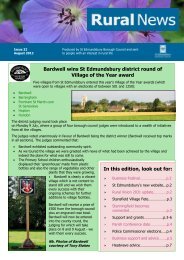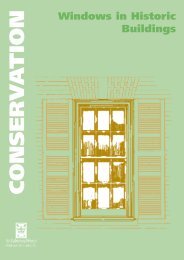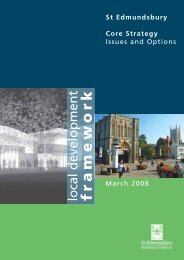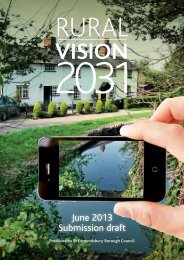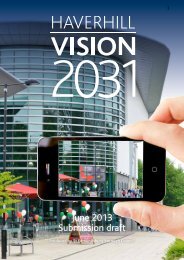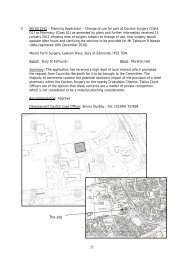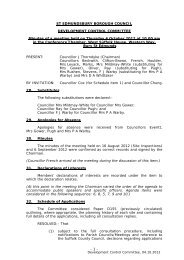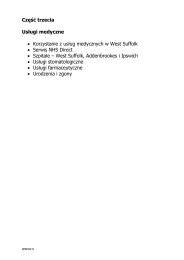St Edmundsbury Core Strategy (December 2010)
St Edmundsbury Core Strategy (December 2010)
St Edmundsbury Core Strategy (December 2010)
Create successful ePaper yourself
Turn your PDF publications into a flip-book with our unique Google optimized e-Paper software.
2. Profile of <strong>St</strong> <strong>Edmundsbury</strong>Geography2.1 <strong>St</strong> <strong>Edmundsbury</strong> is located in western Suffolk. The borough has borders withNorfolk and Breckland district to the north, Mid Suffolk & Babergh districts to thesouth and east, Essex and Braintree district to the south and Cambridgeshire andSouth and East Cambridgeshire districts and Forest Heath district to the west. Whileadministratively links are with Suffolk County Council, the borough is increasinglyplaying a stronger role in the sub-region of Cambridge due to common economic andsocial needs.2.2 The borough has two main towns, Bury <strong>St</strong> Edmunds in the centre and Haverhillto the south. A large number of villages and small settlements ensure thepredominantly rural character is retained despite the pressures of growth in the 20 thCentury.Transport Infrastructure2.3 The borough has improving road and rail links, although these are not consistentacross the area. There is only one rail station, at Bury <strong>St</strong> Edmunds, which currentlyprovides services to Cambridge, Ipswich and Peterborough (for the East-CoastMainline) and London Liverpool <strong>St</strong>reet. However, across the remainder of theborough access to rail services is particularly limited and the opportunity to usepublic transport or journeys to work remain poor and infrequent.2.4 The A14 trunk-road passes east-west through the borough and bisects Bury <strong>St</strong>Edmunds. Recent improvements have provided an additional junction to the east ofthe town but the central and eastern interchanges (junctions 43 and 44) arecongested at peak periods and place restrictions on the ability of the town toaccommodate further growth.2.5 At the southern end of the borough, the A1307 provides a major access routefor Haverhill from the west, including Cambridge and the M11. The majority of thisroad is outside of the borough and once again it suffers from congestion at peaktimes; the Borough Council is, however, working with Cambridgeshire authorities tomanage the demand for car-based journeys along this corridor. In 2008 the A1307attracted considerable press attention across Suffolk and Cambridgeshire following aseries of fatal accidents.2.6 Aside from the A14, the borough‟s road network consists mainly of smaller ruralroads, some of which are narrow in places and can be unsuitable for heavy goodsvehicles. This presents a problem on routes such as the A143 which is the main linkbetween Haverhill and Bury <strong>St</strong> Edmunds and from Bury <strong>St</strong> Edmunds to the ports ofLowestoft and Great Yarmouth and the most direct route from Haverhill to townssuch as Ipswich, and beyond to the other ports of Suffolk.2.7 A proposal to bypass Great Barton was explored by the County Council andrejected in the preparation of the Local Transport Plan. As part of the LDF evidencebase, the Infrastructure & Environmental Capacity Appraisal (2009) has highlightedthat, whilst the road network around both of the main towns is reasonable, newinfrastructure will be required to develop more public transport routes and servicesand to promote the modal shift necessary to accommodate high levels of growth.16


